HISTORIC CUT
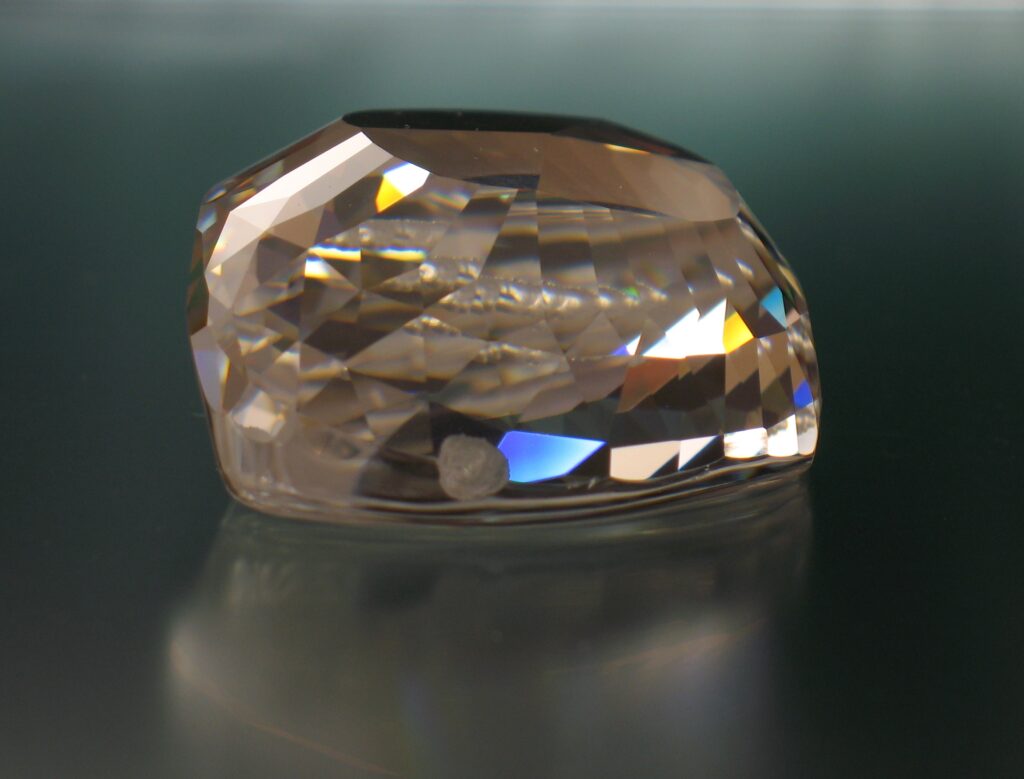
Koh-I-Noor Modern Cut
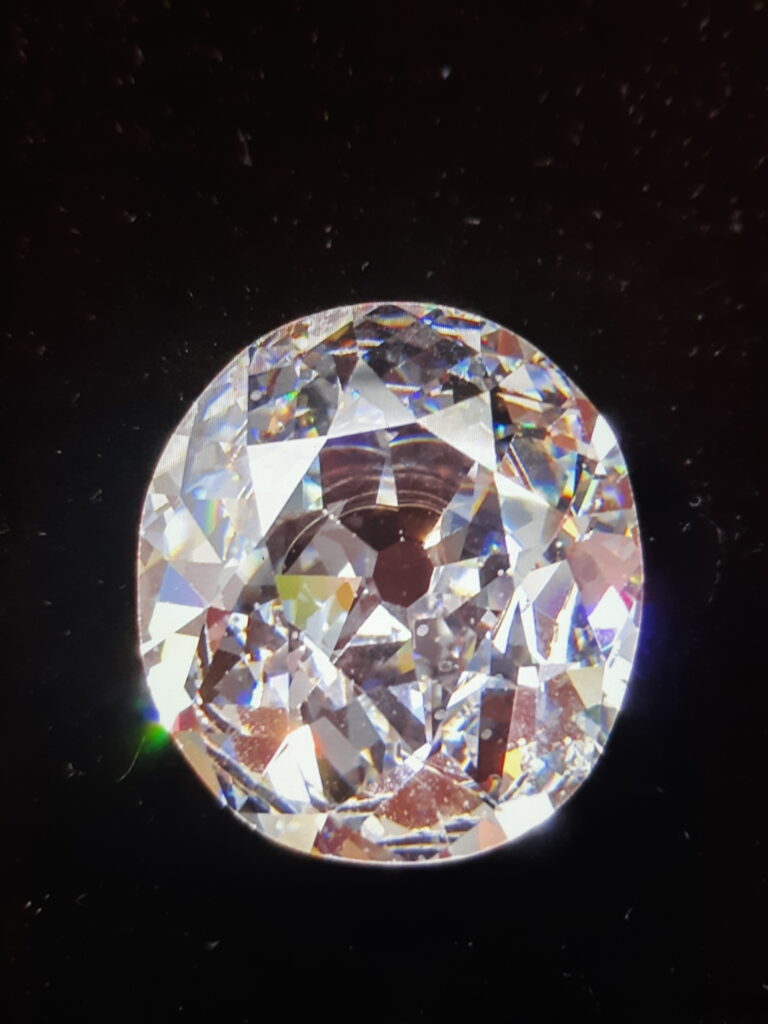
Specifications of Historic Cut
Weight: Approx. 189 carats*
Dimensions: 41.74 x 33.89 x 16.68 mm**
Color: Colorless
Weight of Rough: Unknown
Origin: Golconda, India
Date Found: Unknown; possibly as early as the 1300’s
Current Location: Tower of London; British Crown Jewels
*The historic version was cut into the modern 105.6 carat oval.
**Derived from photos of the plaster cast of the historic cut that resides in the Natural History Museum of London.
Details
The Koh-I-Noor is one of the most fascinating stones in my opinion. It has been a 25 year quest to cut the original 186 carat form. I had wanted to cut it back around 1980 but just couldn’t get enough information to model it, plus the tools to do a good job hadn’t been invented yet. It was put on hold until I got a phone call in March of 2005 from Dale Carriere, a stonecutter who had called me to see if I had any information on it. I told him I had not, but I would be willing to help.
Over the next few months we had conversed via phone and email. The epiphany came when I finally discovered that Coster Diamonds in Amsterdam cut the stone to its current version, a 105 carat (+/-) oval that resides in the British Crown Jewels. (An epiphany to me, probably common knowledge to others, but there were many other projects on-going and this one didn’t get the attention it deserved any sooner than this). Acting on a hunch, I typed in www.costerdiamonds.com on the Internet, and their Web site popped up. It stated that their firm had recut the Koh-I-Noor to its present form. I selected the button “Contact us”, and sent them an email.
At this point, the Hope Diamond program had aired a few months prior, and I mentioned my affiliation with the Smithsonian and the Discovery Channel in the creation of this program. As a result, a very nice young lady responded as she had seen the show. I inquired whether she could send me pictures of the glass model her firm had made in 1851 prior to recutting the stone. She promptly sent me two pictures, but they didn’t have enough information for an accurate model. We spent a few more days e-mailing back and forth discussing how I could get more and better pictures. Finally, she asked if she could just send me one of the two glass models, one that was slightly damaged. This she did (the conversation took place on a Friday, and by noon the next Monday I had it in my hands. Got to love the Dutch, they are very helpful!).
At this point, I called Dale, and he came out from California to participate in the research process over a weekend. We took about 150 pictures, and my co-researcher from the Hope project, Steve Attaway, made several wax models of the glass model. Dale and I also used a Mirror Facet lap to determine index settings and angles for each of the facets. By the time we got done, we knew more about the stone than anyone.
Once slight problem. There was a conflict in the research between the glass model and a drawing by Bauer. Now it became a question of what to believe. Both a line drawing and a glass model are subject to artist’s interpretation, and therefore could contain errors. Another source had to be found to resolve the discrepancy.

Photos of Coster glass replica, created in 1851
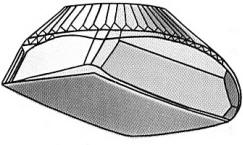
After several months of effort, the appropriate contact was made at the Natural History Museum in London, the depository of two original plaster casts of the KIN created in 1851 before the stone was recut. Being a cast, there is no room for subjective opinion, whatever comes out of the mold is purely objective. This would not only give an accurate rendition of the facet pattern, but also dimensions (accounting for 1-2% difference in size due to the casting process).
Initial contact with the museum was made in March of 2006. After several months of discussion with museum staff, they elected to send one of the plaster casts out for study, and by Aug 2006 it had been received. They were also very generous with their return date, as it could be kept until December. Dale came out again to assist in the research, and over the course of a weekend approximately 600 photos of the stone were taken. These were subsequently analyzed to determine facet size, shape, pattern, placement, angle, and all other possible features so that accurate line drawings could be made. This was accomplished, and modeling started late August.
One thing that became quickly apparent were some “flaws” on the model’s surface. It has been stated in several sources that there were indentations in the side of the stone created so that the stone could be set in a claw-like setting. These are readily apparent as ovals in Dieulafait’s drawing.
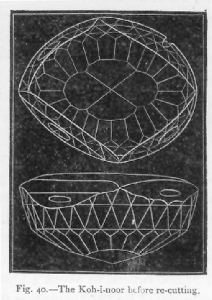
However, there are three other areas best described as “rough spots” that create questions. Are they artifacts of a poor casting? Are they the result of a poorly made mold? Are they real?If they existed in the plaster model back at the museum, then they were more than likely a phenomena on the original stone’s surface. If there was a difference between the models, they would be artifacts of a poor casting. This was resolved when the museum was requested to take photos of these areas and send them for analysis. This they obligingly did. These rough spots are identical on both casts, so these are real phenomena.
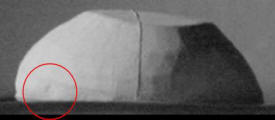
So, are they the result of a poor casting, or a poorly made mold? Since there would be only this one chance to create an accurate model, it is reasonable to expect the process to be as perfect as possible. If there were a defect in the mold, or in the cast, it would be discarded and the process repeated until the result was an accurate representation. This infers that both casts are accurate representations of a real phenomena, and not defects in the mold or casts.
As of September 2006, research of the model and subsequent modeling is still in progress, and preliminary results are tantalizing! Upon approval of the release of the new findings, I will publish the results here on this Web site.
One last side note: There are some people who believe that the three large faces on the side of the stone are cleavage faces, the result of intentional cleaving by the Indians to damage the stone prior to handing it over to the British. All three are clearly not the result of intentionally inflicted damage, as they contain the indentations used for mounting. These pits have rounded edges; if they were cleavages, they would have sharp edges. If damage by cleavage was performed, then someone would have to go back and grind the edges of the pits to make them round, a somewhat arduous task. Also, the facets around the large faces are reminiscent of the cutter “blending” these facets into a pre-existing surface, not ending abruptly as expected if any face were cleaved and leaving sharp edges. Blending the facets would also be expected of a Mogul-style diamond cutter maximizing weight retention during the cutting process.
Because of these factors, and lack of contrary evidence, it is reasonable to conclude that all surface “defects” are the result of natural processes and not some contrivance of man. No intentional damage was inflicted.
November 2007
The past year has been spent further investigating the Koh-I-Noor plaster model. In January 2007, the model was sent to Belgium to get laser and Xray scanned, then returned to the museum. Scanning was done by the grateful participation of Sergei Sivovolenko, President, Octonus Corp., Paul Van Der Steen, Matrix Diamond Technologies, Antwerp, Belgium (laser scanning), and Dr. Alexander Sassov, SkyScan R&D Director, Kontich, Belgium (Xray scanning). They donated the use of their machines to accurately capture the model’s surface topology using the latest in scanning technology. Their equipment is normally used in the diamond trade for evaluating diamonds, and I was truly amazed at the capabilities of both the hardware and software (DiamCalc). Gary Holloway of Gary Holloway Diamonds in Australia provided instruction for using the DiamCalc software to reduce the 5047 planar surfaces from the scan data into the 169 facets on the replica. This data was subsequently used to create a CZ replica of the historic version of the Koh-I-Noor.
December 2007
My wife, Karen, and I traveled to London for the opening of the “The Vault” exhibit at the Natural History Museum in London. The second to last day there, Alan, the Curator of Gems and Minerals, gave us a tour of what we referred to as “The Attic.” This was an area of the museum not open to the public. These rooms contain specimens not currently on display. Alan showed us the cabinets of specimens, and also a drawer or two of famous diamond replicas. Some replicas were glass, others lead or plaster.
Once we finished ogling all this, he said, “I have something I would like you to see.” He promptly led us through a rabbit warren of back rooms and stairs and ushered us into a rather well-lit room. He pointed to a blue velvet display stand with glass diamond replicas around its perimeter.
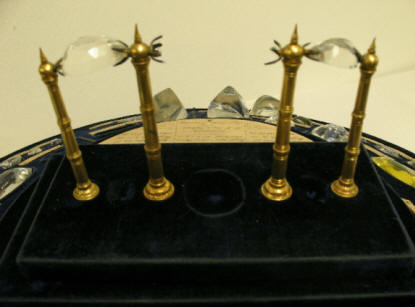
At the top of the display were what appeared to be four gilded brass posts, with cup-like stone holders near the top. The outer pairs of posts had glass replicas of what appeared to be the side diamonds from the original armband mounting of the Koh-I-Noor diamond. (Having visited the Tower of London the previous day, and spending a lot of time staring at the original, I knew exactly what the replicas were.) The two middle posts had a cupped stone-holder each, indicating there should be a larger central stone.
Alan asked me what I thought the display was. I said that it looked like the original display stand from Queen Victoria’s Great Exhibition of 1851, the one that held the original Koh-I-Noor diamond before it was re-cut. He concurred with my hypothesis. He then added that the only way to prove that it was the original display would be to take a CZ replica of the original Koh-I-Noor and to place it between the two posts. If the replica fit, it would be conclusive. (And if it didn’t fit, it would be equally conclusive!)
What Alan didn’t know was that my wife and I always “carry backup” when we go on trips such as this. We had brought with us replicas of the three blue diamonds (for the museum in France), plus the pink Great Table replica. I also had packed my replica of the Koh-I-Noor in the event the museum’s replica were to become damaged prior to going into the exhibit.
So, as soon as Alan had posed the challenge, I looked across the room at my wife. Karen caught my eye, and just smiled and nodded. Without a word, she took the backpack off her back, pulled out the Tupperware container with the five replicas, and then unwrapped the KIN replica and put it in my hands.
As Karen and Alan stood wide-eyed in anticipation, I gently placed the replica between the posts of the display and pressed down ever so slightly. The replica snapped right into place! It fit like a glove. It was as if the posts were custom-made for it.
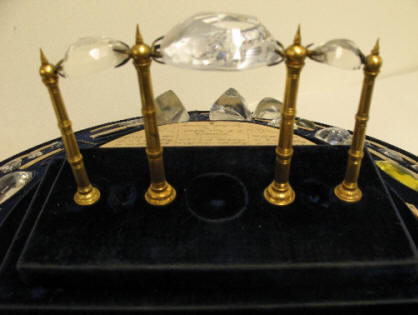
All three of our jaws dropped to the floor. All we could do was just point and stare until – finally — we all started talking at once with lots of excitement and animation.
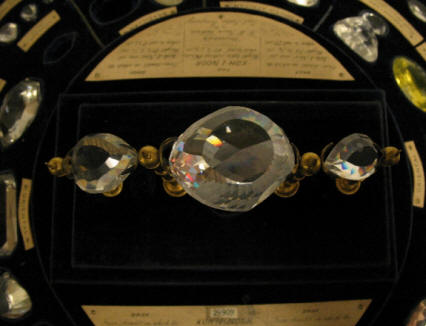
The gist of the cacophony was “there could be no doubt” and “what a perfect fit.” We agreed that this was conclusive proof that the blue velvet display, the one that had been stored in obscurity for more than a century in “The Attic” of the Museum of Natural History, London, is in fact the original display stand for the KIN used over 150 years ago, and seen by Queen Victoria herself.
April 2009
I’m a little remiss in not updating this sooner.
The outcome of the study concerning the Koh-i-Noor not only allowed a recreation in CZ of the historical form, but it also disproved the link between the Great Mogul and the KIN as postulated by Ball (1926) and others.
Both the modern and historic versions were modeled, and a special GemCad utility allowed me to put the smaller inside the larger and position them very precisely. This allowed an analysis of how one was cut from the other. Combined with information provided by Tennant (1851), it becomes very clear that the modern stone, though lacking the attributes of modern cutting that would call it beautifully cut, was the best that Coster Diamonds could do given the constraints of shape, inclusions, and yield. Many people did not like the recutting, but careful analysis of the data shows that the cutter did the best possible job given the constraints. So get off his back already! This research was published in detail (about 17 pages) in an article (Sucher et al, 2008) and both the historic and modern models were on display for a year at the Natural History Museum in London as a part of their “The Vault” exhibit.
May 2009
In early April, I was contacted by Aymeric Peniguet de Stoutz, who is responsible for the historical and modern collections of the Domaine of Chaumont-sur-Loire, plus the historical counselor for the “Aux Armes de France et de Navarre” in the Loire Valley, France. He noticed that my pavilion pattern of the modern Koh-i-Noor did not match that of Tillander (1995) who showed more of a stellar cut with an additional row of pavilion facets. He was in fact correct, the pattern did not match Tillander. However, was Tillander right? I had access to this drawing prior to cutting the KIN, but for some reason it completely slipped my mind.
It took about six weeks, but I finally found a photo taken somewhat obliquely in The Crown Jewels: The History of the Coronation Regalia in the Jewel House of the Tower of London, Vol II. There were only 650 copies of this two volume set created, so they are very expensive and very limited in distribution. However, Richard Wise, whom I met through an interesting email train, was kind enough to photograph the required pages and emailed them. Lo and behold, Aymeric was correct, the photo shows an extra row. I am now in the process of redesigning this stone. Unfortunately, I need to replace the replica at the Natural History Museum in London, plus the one in my collection, so it looks like I have some more work to do. I want to thank Aymeric for pointing this out, as it is my goal to correct the historical record, not muddy it more than it already is.
